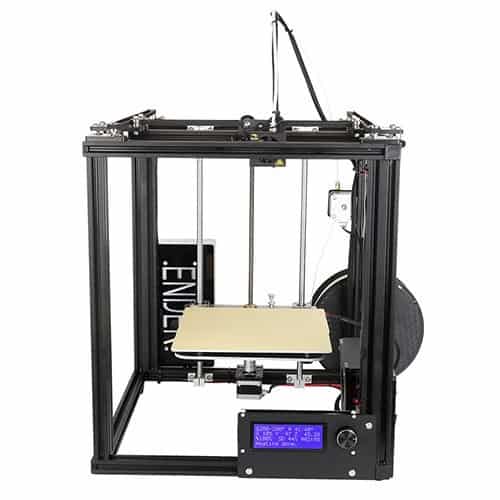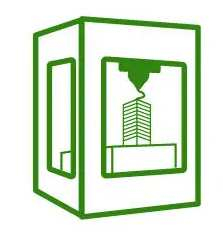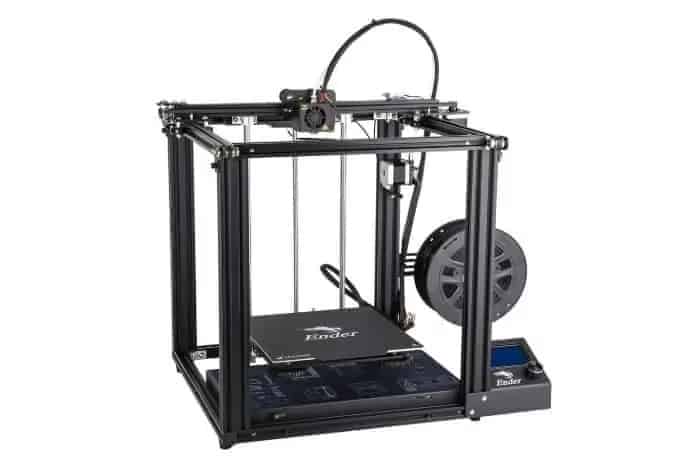Desktop 3D printing hardware is getting crowded for a niche market.
Fortunately, growing interest means growing competition between companies trying to top each other with the latest upgrades.
Here we’re comparing two models that fit into the same desktop printing arena to see which 3D printer comes out on top. Read on for details that will help you decide if the Creality Ender 5 or the Anet A8 best fits your 3D printing needs.
Bottom Line Up Front Summary: For most aspiring 3D printers, I recommend the easier to setup, easier to use, and quieter Creality Ender 5 available here. That said, the Anet A8 is a solid option if you are really into customization and upgrades.
Ender 5 Pro 3D Printer | Creality3D
The Ender 5 3D printer is a very well-designed device, with faster printer, and more build volume than it’s predecessors. If you can afford it, it’s worth the additional investment long term.
The Main Differences Between Creality Ender 5 vs Anet A8
The main difference between Creality Ender 5 and Anet A8 is that:
- The Creality Ender 5 printer is relatively easy to set up, whereas the Anet A8 is more complicated (requires some skill and patience)
- The Creality Ender 5 is super quiet (even with all the moving parts), whereas the Anet A8 is expectantly louder (so not as great in shared spaces)
- The Creality Ender 5 is a popular choice amongst self-taught 3D printers, whereas the Anet A8 is for more advanced users (but is half the cost, with more modification possibilities)
Background Information on the Ender 5 and Anet A8
Creality and Anet have both come out with new desktop models of 3D printers in 2018. Creality is a company based in China and started in 2014 to manufacture and export 3D printers and supplies. Their team of 12 engineers comes out with two to three new models per year, so they are constantly updating for new consumer needs and improving old versions. Their partnerships with sellers like Amazon make it easy for any DIY hobbyist to buy their products anywhere in the world you might need to ship to.
One thing to keep in mind about Creality, in general, is its contentious past workings with open source resources. Third-party selling site Printed Solid ended its relationship with the company in April 2018 based on this. But since then, Creality has announced changes – in July, they announced that their Ender 3 3D printer building specifications are now open source, which means all the details of the parts, manufacturing process, and blueprints are available for free for anyone who wants to see them. Check out our Ender 3 Review here. f
This major transparency bid might be a piece of news that sways you towards this brand if you feel more comfortable knowing all the details about what you’ll be dealing with. Open source building specifications also make it easier for you to figure out exactly what you need if something breaks or goes wrong. Or, on a more practical note, if you love tinkering with your machines, being able to look up the blueprints can give you a good idea of what you can do to modify it.
Anet is also based in China. Its corporate structure is similar to Creality’s and so is its product line, which includes 3D printers themselves as well as parts and other accessories. The company started up in 2015, and they release six different printers in 2017.
They have warehouses all over the United States, and elsewhere in the world, so they’re available internationally as well. Anet has not had to deal with the copyright and open access issues that Creality has, so if those issues make you wary, Anet will have your back (although to be fair, as mentioned, Creality does seem to be correcting themselves into more transparency).

Now let’s get down to specifics:
| Year | 2018 |
| Printing type | Fused Deposition Modeling |
| Price | $399 (check latest) |
| Frame | Aluminum |
| Printer size | 452 mm x 468 mm x 482 mm |
| Printing space size | 220 mm x 220 mm x 300 mm |
| Printer weight | 15 kg |
| Power input | 250W |
| Nozzle diameter | 0.4 mm |
| Maximum nozzle temperature | 260 degrees Celsius |
| Filament size | 1.75 mm |
| Usable filaments | ABS, Carbon Fiber, CopperFILL, Flexible, Nylon, PETG, PLA, PVA, TPU, WoodFill |
| Display | LCD |
| Heated bed | Yes |
| Removable bed | No |
| Maximum bed temperature | 100 degrees Celsius |
| Accuracy | Z-axis 0.04 mm, X/Y axes 0.012mm |
| Maximum printing speed | 200 mm/sec |
Further Reading: My Top Ender 5 Upgrades and Modifications.
Creality Ender 5 Pros
- The build of the Ender 5, which deviates from its predecessors in this series, boasts a four-corner open body plan instead of the traditional full sides open body. This gives you more space to print and more stability because its aluminum framing braces the whole printing bed rather than just supporting the extruder segment.
- Silent printing. 3D printing can get downright cacophonous with all its moving parts, motors, and grinding gears, but the Ender 5 makes you wonder why all that is necessary. It’s so quiet you’ll be checking on it frequently to make sure it’s working until you get used to how silently it can whip across the axises. You’ll still hear the motor, but not until you get up close, which is great for anybody who wants to 3D print in areas close to people who are doing other things, like a home office, dorm room, or library maker space.
- Motor heat. Or lack thereof – even after twelve hours of continuous printing, the motors barely get warm to the touch, much less overheated. This is welcome news for a technology that tends to run hot just when that’s most inconvenient.
- Auto bed leveling. The expert calibration and movement smoothing of this model means you don’t have to adjust between layers or different printings, which is a significant time saver whether you’re doing multiple projects on a tight timeline or just don’t want to have to add an extra step to each of your processes.
- Layer conformity. The 0.2mm layers blend into each other for an almost seamless finished surface. You’ll still be able to see the layers, but not unless you look very closely at the finished project. This makes for an excellent sculpting experience for projects that look more professional than those printed with chunkier layers.
- The printer also does well with designs that have gaps or spaces. There’s very little stringing, and most of that comes from maladjusted temperature for the filament used, which can be easily fixed.
Creality Ender 5 Cons
- Extruder heat. The motor heat may be ideal, but watch out for heat creep issues with the extruder end. That may be due to the cooling fan speed not being powerful enough for what’s needed with that sort of heat. This printer is supposed to work with many types of standard filaments, but the only type that shows a 100% success rate is PLA. Make sure you are willing to put in the extra filament and extruder monitoring if you plan on using a different type of filament.
- Runs locked Marlin. Since you don’t have a chance to change this printer’s firmware, you have to go with what they give you without any ability to fix it yourself if a bug comes up.
- Adjusting Z offset. Even though the auto bed leveling works beautifully during printing, if you want to adjust your Z setting, you have to use its sensor, which is much more tedious than adjusting in the menu like you can your X and Y axises.
- Filament runout sensor. This part of the printer seems to be very spotty about actually figuring out whether the filament is still there or not. It has been known not to notice the filament has run out and to keep printing, so if you aren’t able to guarantee you’ll have enough filament for a complete job, be prepared to keep a close eye on your filament supply.
- Laser grid language barrier. There is a laser grid program on the SD card that comes with the printer, and it lets you install a laser grid program on your computer to use with the printer. It’s supposed to have options for a variety of languages, but unfortunately, a lot of those programs only open in Chinese without any way to choose another language before it installs. Hopefully, this will be fixed soon in an update.
Conclusion
The Reality Ender series has a great reputation as a top-rated 3D printer for beginners and hobbyists. Its latest iteration, the Creality Ender 4, continues to make it a favorite for self-taught, self-funded 3D printing enthusiasts.
Ender 5 Pro 3D Printer | Creality3D
The Ender 5 3D printer is a very well-designed device, with faster printer, and more build volume than it’s predecessors. If you can afford it, it’s worth the additional investment long term.
| Year | 2018 |
| Printing type | Fused Deposition Modeling, Fused Filament Fabrication |
| Price | $200 (check latest here) |
| Frame | Acrylic plate (with aluminum print bed) |
| Printer size | 510 mm x 400 mm x 415 mm |
| Printing space size | 220 mm x 220 mm x 240 mm |
| Printer weight | 8.5 kg |
| Power input | 12V |
| Nozzle diameter | 0.4 mm |
| Maximum nozzle temperature | 260 degrees Celsius |
| Filament size | 1.75 mm |
| Usable filaments | PLA, PETG, ABS, Woodfill, Nylon PVA, PP, and others |
| Display | LCD |
| Heated bed | Yes |
| Removable bed | No |
| Maximum bed temperature | 96 degrees Celsius |
| Accuracy | 0.04 mm Z axis, 0.12 mm X/Y axes |
| Maximum printing speed | 100 mm/sec |
Anet A8 Pros
- Cost. This is one of the best 3D printers balanced between low price and good quality. You can buy the kit for less than $200, which makes it accessible for people who want to get into 3D printer but haven’t yet because of prohibitive prices.
- Open design. An advantage for the more experienced printers is that this kit is also super customizable. Don’t like how a particular part works from your kit? Find a mod on the internet and adjust to your heart’s content. This printer’s minimalist design also makes it easy to correct any assembly mistakes or take apart any areas that may develop issues, like a clogged printer nozzle. This is a great way to basically take your own crash course in 3D printing from the ground up.
- Print quality. Once you figure out your calibrations, your printed objects will come out beautifully, especially for this printer’s price range. Its axis accuracy is listed as lower than the Creality Ender 4’s, but the gapping between layers is just as nonexistent. And once you’ve started working with it, the A8 will get more responsive and personalized with each tweak and modification. You can truly make this into your own machine.
Anet A8 Cons
- Unhelpful assembly instructions. If you’re looking for a 3D printing experience you can quickly set up and get going right away; the A8 will definitely slow your roll. The instructions that come with the kit are not clear and can stretch out your build time considerably if you don’t have alternates ready – especially since there is no physical booklet, just a USB stick with a video. Fortunately, the A8 has been out long enough for you to find much better user-generated content for free on the internet. Just remember that you will still have to build the printer before you can build any of your designs.
- Some pieces need modification to work right. You may have to deal with situations of pieces not sitting quite so true, like with the plug-in for the extruder fan. However, there are lots of modifications available on 3D printing websites, and they’re easy to produce for your exacting experience. If you’re just getting into 3D printing, it may seem intimidating or unnecessary.
- Lack of power switch. This is an odd omission from the kit and means you have to remember to unplug the printer every time you want to power down. For people who have to deal with badly placed wall outlets or crowded power strips, this could become a literal pain in the butt.
- Loose wiring in the extruder. A common problem with this model is the wiring attached to the heating block was loose. It’s easily fixable and can be avoided in the future with strategically applied thermal paste, but you may not have occasion to notice it until it starts smoking, so watch out.
- Manual printing bed calibration. Make sure you keep track of your screwdriver rotations, so you don’t get lost in the calibration process. You should also check the belt tension beneath your printing bed if you’ve calibrated as needed but are still getting warping in your printing.
Final Verdict: Creality Ender 5 vs Anet A8
Although the list of cons is technically longer than the list of pros, Anet has, in fact, knocked it out of the park with the A8 3D Printer
It’s a great printer for a low price, and the only users who may get prohibitively frustrated are those who want to get straight to the actual printing and don’t care or need to know about the printer itself.
The ability to modify and tweak the original kit is dependent on the internet at large and not the company, which would be an issue if the 3D printing community weren’t so forthcoming with free and open solutions.
But building this Anet A8 kit will give you a sense of accomplishment and let you figure out exactly what you like in your printer, all for under $200 (check here for latest price).
So there you have it – Creality Ender 5 vs Anet A8. Based on usage tests, the Anet A8 seems to be an overall more intuitive and bug-free choice.
However, if you’re looking for more structural support, a wider variety of updates available, and aren’t afraid of a little hardware modification, the Creality Ender 5 comes out on top.
Bottom Line Up Front Summary: For most aspiring 3D printers, I recommend the easier to setup, easier to use, and quieter Creality Ender 5 available here. That said, the Anet A8 is a solid option if you are really into customization and upgrades.
Only you can decide the ultimate winner between these two. If you’ve tried one or both of them out, let us know what you think!
Ender 5 Pro 3D Printer | Creality3D
The Ender 5 3D printer is a very well-designed device, with faster printer, and more build volume than it’s predecessors. If you can afford it, it’s worth the additional investment long term.





Recent Comments